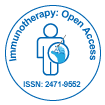
Imunoterapia: acesso aberto
Acesso livre
ISSN: 2471-9552

ISSN: 2471-9552
Sabrina Manni*, Laurène Lotte, Antonin Bal, Laurence Josset, Bruno Lina, Mary Anne Trabaud, Gregory Destras, Bruno Pozzetto, Martine Valette, Corinne Passeron, Barbara Seitz-Poslki, Audrey Sindt, Matteo Vassallo
Introduction: End stage kidney disease (ESKD) and cancer have been identified as risk factors for severe and fatal cases of COVID-19, making vaccination in these patients a priority. Patients suffering from ESKD have a significantly weaker response to common vaccines than general population. However, humoral and cellular immune responses after two doses of RNA-based vaccine BNT162b2 (Pfizer–BioNTech) have been poorly explored in this vulnerable population.
Case presentation: A 69-year-old male patient was followed for ESKD and myeloma treated with Daratumumab. He developed a severe SARS-CoV-2 pneumonia treated with oxygen supplementation and dexamethasone twenty days after two doses of BNT162b2 vaccine. Whole genome sequencing found that the virus belonged to the 20I/501Y.V1 clade. A serology draws eight days after the 2nd vaccine dose showed positive RBD IgG without neutralizing activity against three live viral isolates. A serum specimen sampled thirty days after the onset of SARS-CoV-2 infection showed seroconversion against both RBD and N antigens. This specimen was shown to exhibit a frank neutralizing activity with a higher titer on 20I/501Y.V1 virus than against the reference virus or the 20H/501Y.V2. The QuantiFERON® SARS-CoV-2 (Qiagen) showed a positive specific cellular response although the QuantiFERON monitor displayed a weak cellular response.
Conclusion: Impaired immunity due to renal failure probably explains the severe pneumonia despite vaccination. In fact, it is well-know that dialyzed patients showed bad vaccination response. The fact that the patient develops a neutralizing activity and a cellular response after a third stimulation by infection may suggest to systemically administrating a third supplementary dose of vaccine in ESKD patients as for hepatitis B.